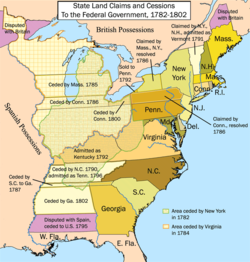
Back عهد الكونفدرالية الأمريكية Arabic Konfederasiya dövrü Azerbaijani Periodo della Confederazione Italian 연합규약 시대 Korean د متحده ایالاتو کنفدریشن دوره Pashto/Pushto Конфедеративный период Russian Konfederasyon Dönemi Turkish
The United States of America | |||||||||
|---|---|---|---|---|---|---|---|---|---|
| 1781–1789 | |||||||||
| Motto: E pluribus unum (Latin) "Out of many, one" | |||||||||
| Anthem: None official | |||||||||
 Map of the United States and territories after the Treaty of Paris (1783) | |||||||||
| Status | Unrecognized state (Until 1783) | ||||||||
| Capital | Philadelphia (1781–1783) Princeton (1783) Annapolis (1783–1784) Trenton (1784) New York City (1784–1789) | ||||||||
| Government | Revolutionary confederal republic (1781-1783) Confederal republic (1783-1789) | ||||||||
| President of the Congress | |||||||||
• 1779–1781 | Samuel Huntington (first) | ||||||||
• 1788 | Cyrus Griffin (last) | ||||||||
| Legislature | Congress of the Confederation | ||||||||
| Historical era | American Revolution | ||||||||
| March 1, 1781 | |||||||||
| September 28, 1781 | |||||||||
| June 20, 1783 | |||||||||
| September 3, 1783 | |||||||||
| August 29, 1786 | |||||||||
| May 25, 1787 | |||||||||
• States begin ratification of Constitution | December 7, 1787 | ||||||||
| March 4, 1789 | |||||||||
| Currency | Continental Currency | ||||||||
| |||||||||
| Today part of | United States Canada | ||||||||
| Confederation period | |||
|---|---|---|---|
| 1781–1789 | |||
Chronology
| |||
The Confederation period was the era of the United States' history in the 1780s after the American Revolution and prior to the ratification of the United States Constitution. In 1781, the United States ratified the Articles of Confederation and Perpetual Union and prevailed in the Battle of Yorktown, the last major land battle between British and American Continental forces in the American Revolutionary War. American independence was confirmed with the 1783 signing of the Treaty of Paris. The fledgling United States faced several challenges, many of which stemmed from the lack of an effective central government and unified political culture. The period ended in 1789 following the ratification of the United States Constitution, which established a new, more effective, federal government.
The Articles of Confederation established a loose confederation of states with a weak confederated government. An assembly of delegates acted on behalf of the states they represented. This unicameral body, officially referred to as the United States in Congress Assembled, had little authority, and could not accomplish anything independent of the states. It had no chief executive, and no court system. Congress lacked the power to levy taxes, regulate foreign or interstate commerce, or effectively negotiate with foreign powers. The weakness of Congress proved self-reinforcing, as the leading political figures of the day served in state governments or foreign posts. The failure of the confederated government to handle the challenges facing the United States led to calls for reform and frequent talk of secession.
The Treaty of Paris left the United States with a vast territory spanning from the Atlantic Ocean to the Mississippi River. Settlement of the trans-Appalachian territories proved difficult, in part due to the resistance of Native Americans and the neighboring foreign powers of Great Britain and Spain. The British refused to evacuate US territory, while the Spanish used their control of the Mississippi River to stymie Western settlement. In 1787, Congress passed the Northwest Ordinance, which set an important precedent by establishing the first organized territory under the control of the confederated government.
After Congressional efforts to amend the Articles failed, numerous American leaders met in Philadelphia in 1787 to establish a new constitution. The new constitution was ratified in 1788, and the new federal government began meeting in 1789, marking the end of the Confederation period.
| This article is part of a series on the |
| History of the United States |
|---|
 |
© MMXXIII Rich X Search. We shall prevail. All rights reserved. Rich X Search

